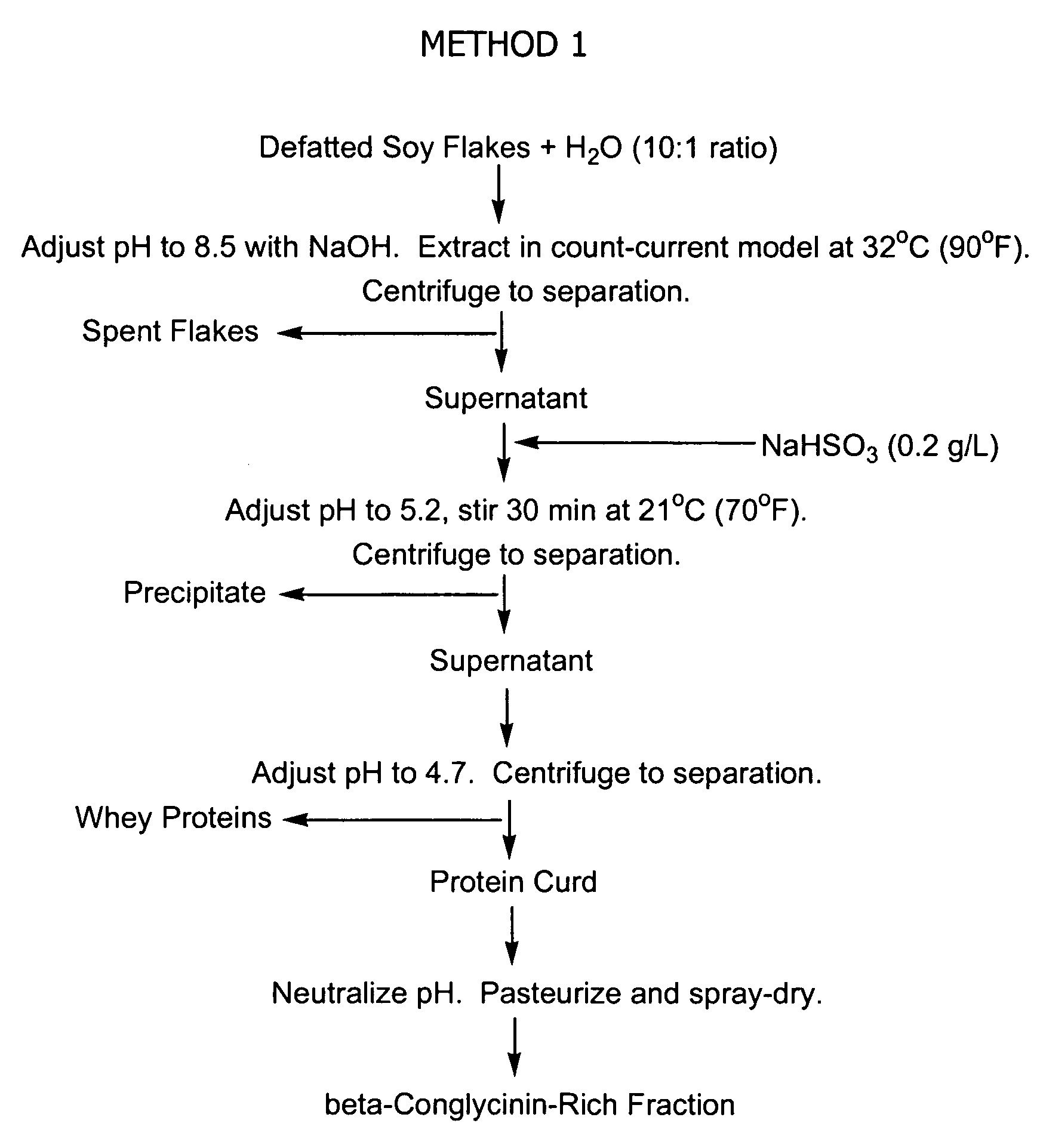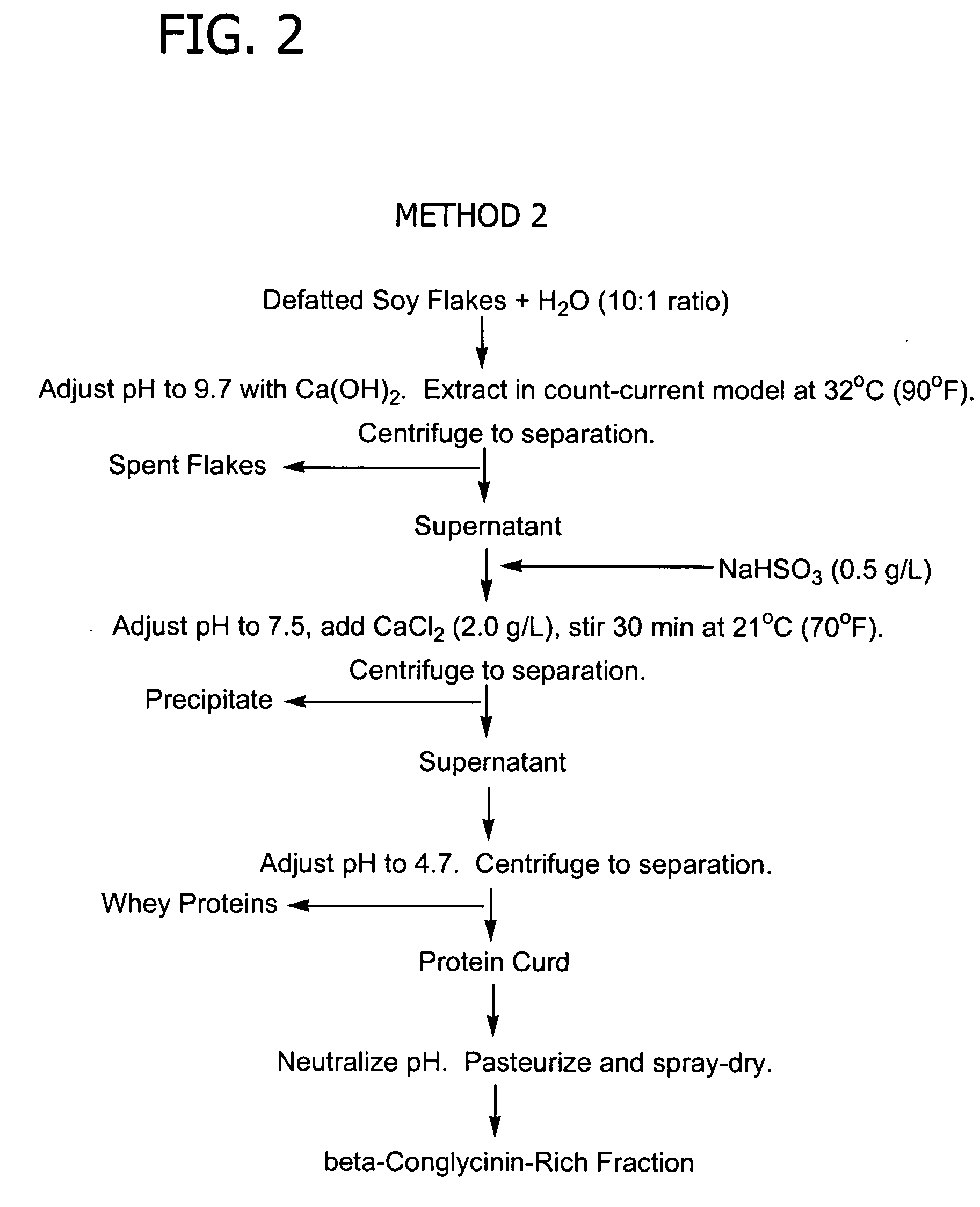Process for the preparation of glycinin-rich and beta-conglycinin-rich protein fractions
a technology which is applied in the field of process for the preparation of glycinin and betaconglycinin protein fractions, can solve the problems of unsuitability for incorporation into food products, poor functionality of intermediate fractions, and considerable expense in handling and disposing of waste streams
- Summary
- Abstract
- Description
- Claims
- Application Information
AI Technical Summary
Benefits of technology
Problems solved by technology
Method used
Image
Examples
example 1
[0171] This example demonstrates preparing glycinin-rich and β-conglycinin-rich fractions from a soy protein extract solution using various amounts of calcium chloride. Various amounts of calcium chloride are added to an extract solution containing soy protein in four separate precipitations.
[0172] For each of the four separate precipitations, the soy protein extract solution is prepared by contacting a mixture of defatted commodity white soybean flakes produced by Cargill, Inc. (Minneapolis, Minn.) and water (10:1 weight ratio of water to flakes) with calcium hydroxide at a pH of 9.7 and a temperature of 32° C. (90° F.) for 15 minutes. The soybean flakes contain 50% by weight protein. The flakes contain from 10-15% β-conglycinin and from 40-55% glycinin, on a total protein basis.
[0173] Sodium bisulfite (0.5 g, 0.2 g / l) is added to the extract solution. In each run, hydrochloric acid (1.0 M) is added to the solution to adjust the pH to 7.5 and calcium chloride is added to the extr...
example 2
[0184] This example demonstrates the influence of pH when preparing glycinin-rich and β-conglycinin-rich fractions from a soy protein extract solution to which calcium chloride is introduced as described above in Example 1.
[0185] The pH of an extraction solution prepared as described above in Example 1 is adjusted to enhance precipitation of a glycinin-rich fraction therefrom.
[0186] Sodium bisulfite (0.5 g / l extract solution) is added and the pH is adjusted by adding hydrochloric acid (1.0 M) in five separate runs during which the pH is adjusted to 7.5, 7.0, 6.5, 6.0, and 5.5, respectively.
[0187] Calcium chloride (1.0 g / L extract solution) is added to each of the extraction solutions after its pH is adjusted to the desired level. A glycinin-rich precipitate is separated from the supernatant by centrifugation as described above in Example 1. The pH of the supernatant is then adjusted to 4.8 by the addition of hydrochloric acid (1.0 M) to precipitate a fraction rich in β-conglycini...
example 3
[0191] This example demonstrates the effect of addition of sodium bisulfite as a reducing agent when preparing glycinin-rich and β-conglycinin-rich fractions from a soy protein extract solution prepared as described above in Example 1.
[0192] Five precipitation runs, varying only in the amount of sodium bisulfite added to the extraction solution before precipitation of the glycinin-rich fraction, are carried out. The amounts of sodium bisulfite added to the extracts for each run are 0.1 g / l extract, 0.2 g / l extract, 0.3 g / l extract, 0.4 g / l extract, and 0.5 g / l extract. During each run, the respective amount of sodium bisulfite is added to the extract at pH 9.7.
[0193] Calcium chloride (1 g / l extract) is added to the extraction solution to precipitate a glycinin-rich fraction. The pH of the extract solution is then adjusted to 6.2 by addition of hydrochloric acid (1.0 M) for glycinin precipitation and a glycinin-rich precipitate is separated from the supernatant by centrifugation as...
PUM
| Property | Measurement | Unit |
|---|---|---|
| Temperature | aaaaa | aaaaa |
| Temperature | aaaaa | aaaaa |
| Temperature | aaaaa | aaaaa |
Abstract
Description
Claims
Application Information
 Login to View More
Login to View More - R&D
- Intellectual Property
- Life Sciences
- Materials
- Tech Scout
- Unparalleled Data Quality
- Higher Quality Content
- 60% Fewer Hallucinations
Browse by: Latest US Patents, China's latest patents, Technical Efficacy Thesaurus, Application Domain, Technology Topic, Popular Technical Reports.
© 2025 PatSnap. All rights reserved.Legal|Privacy policy|Modern Slavery Act Transparency Statement|Sitemap|About US| Contact US: help@patsnap.com



